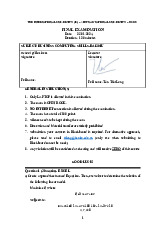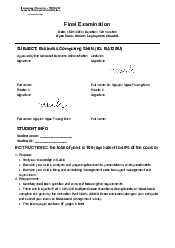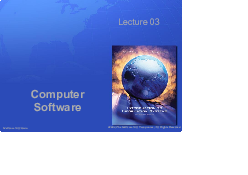























































Preview text:
lOMoARcPSD|36490632 Chapter 4’
Technology and Agglomeration
Instructor: Dr. Nguyen ThiPhuong Chau lOMoARcPSD|36490632 eradicate distance? Aims to study:
• To demonstrate how certain kinds of technologies can be used to transcend time and space
• To appreciate the limits of the spatial impacts of technology on economic systems
• To understand why proximity still matters of many different kinds of economic activity
• To reflect on the importance of relational proximity in shaping
contemporary economic geographies lOMoARcPSD|36490632 lOMoARcPSD|36490632 Outline 1. Introduction
2. The rise of “Placeless” Production?
3. Understanding technological changes and their geographical impacts
4. Proximity matters: traded and untraded
interdependencies within clusters
5. Neither here nor there: thinking relationally lOMoARcPSD|36490632 lOMoARcPSD|36490632 “Placeless” production • Overlapping financial markets in different time zones • Engage in 24- hours-a-day trading • Connections between different markets lOMoARcPSD|36490632 “Placeless” production
eBay – a very real and uneven geographies, is largely a rich country
phenomenon replying as it does upon both the availability and affordability
(in local terms) of internet access, which is very patchy at global scale lOMoARcPSD|36490632 Wal-Mart eBay • Traditional supermart • Online shop
• Deal with producer, intermediate • Most buyers + sellers
sellers, and consumers within and
transact within their ‘home’ aboard/oversea countries national territory
• Goods exchanged still have to be moved through the real world of postal, freight, and
logistics services and customs, and import/export taxes and duties
3. Understanding technological changes and their geographical impacts
• Technology must be seen not as a technical process with a life
of its own, but rather as a social process through which
individuals and organizations deploy technologies to achieve certain ends lOMoARcPSD|36490632
• Different kinds of space-shrinking technology: transport and communications technologies
• Different levels of technological change: partly application, robot
replaced human workers, automobile production lines, etc. lOMoARcPSD|36490632
Technological change needs to be placed in a long-term or evolutionary
perspective: The different spatial outcomes of each wave of new technology have
interacted with patterns ofactivityleft overform the precedingwave. (p.124) lOMoARcPSD|36490632 lOMoARcPSD|36490632
3. Technological changes and geographical impacts New technologies New transportation
New communication technology • High-way road Information technologies: • Airplane • Internet connection • Ship • Wifi, V-Lan, etc. • Train
• GPS (Geographical Position • Cable System) • Pipelines, etc. • etc. lOMoARcPSD|36490632
3. Technological changes and geographical impacts New transportation • Done in ways that are hugely uneven in social and geographical terms • Transfer more goods (incl. people) and services lOMoARcPSD|36490632
3. Technological changes and geographical impacts New information technologies In-car GPS navigation • ‘Placeless’ technology –end of geography • More exactly, flexibly and various forms • Reality full of spatial inequalities and contradictions of different kinds lOMoARcPSD|36490632 Nano technologies lOMoARcPSD|36490632
3. Technological changes and geographical impacts New technologies
• Done with uneven in social and geographical terms
• Placeless technology reality full of spatial inequalities and
contradictions of different kinds
• More exactly, flexibly and various forms
• Shrinking technology to reinforce existing patterns of inequality
• Allow more people and places(locations) to interact with the global capitalist system
• New trend/propensityfor related firms to agglomerate in
cluster intangible new nodes in global economy lOMoARcPSD|36490632
3. Technological changes and geographical impacts Space-shrinking technologies
• Space-shrinking technologies:
– have in common, ability to help their users partially overcome the constraints of space and time.
– Connect firms workers, governments, and consumers together in different ways • Two important kinds of space-shrinking technologies: – Transportation systems:
e ans by which material goods (and people) are transferred between places – Communications system e s:
nable the transmission of various kinds of
information (text, numbers, images, video clips, music files, computer programs) between places lOMoARcPSD|36490632
3. Technological changes and geographical impacts
Space-shrinking transportation technologies
• Advent of commercial jet aircraft: more people
• , Advent of containerization
high value terms, and fresh products Boeing 787 Airbus 380 lOMoARcPSD|36490632 Port of Singapore
A key node in the global container system: the Port of Singapore lOMoARcPSD|36490632 ChânMâyPort, ĐàNẵng lOMoARcPSD|36490632 lOMoARcPSD|36490632
3. Technological changes and geographical impacts
Space-shrinking communication technologies
• Satellite and optical fibre technology:voice, images, and other data transfer/transmit
• Optical fibre with high electricity: data transfer very high speed
• The internet:mass users – interactive • Mobile telecommunications
• Electronic mass media: 1980s – combination of deregulation
and new outlet of cable and satellite television: BBC, CNN, MTV, Fashion TV, radio, etc.
more TV channels available in many countries
inequality in access to the media across the
globe more users in high-income countries lOMoARcPSD|36490632
geographical impacts on space-shrinking technologies? New transportation New information Nano technology • Spatial technology • Spatial interaction? • Spatial interaction? • Constraints? interaction? • Constraints? • Constraints? lOMoARcPSD|36490632 Saigon port system: geography limit to space-shrinking transportation lOMoARcPSD|36490632 Internet and computer using in Cuba In 1998:
• Cuban IP connectivity was minimal,
with perhaps as few as 100 users.
• IP point of network connectivity was only at CENIAI in Havana
• more than 10% of the ministries had
email accounts • poor telephone infrastructure • Source:
http://som.csudh.edu/fac/lpress/articles/acmfwk/acmfr wk.htm 2004 2005 2006 2007 2008 2009 Number of computers 300 377 430 509 630 700 Computers on the Internet 193 243 258 330 400 455 Internet users 940 1,090 1,250 1,310 1,450 1,600 Users per 4. 3. computer 4.9 4.5 8 4.0 6 3.5 lOMoARcPSD|36490632
Space-shrinking technologies Call
center – wide range of support services
• Services provided via telephone:
– Sales, marketing, technical supports, claims enquiries, market research,
reservations, information provision
• Other services from Call center:
– Claim and accounts processing, payroll processing, data processing, and invoice administration, etc.
– Information technology services: software development application testing, and content development, etc.
3. Technological changes and geographical impacts lOMoARcPSD|36490632
Leading sectors involved in offshoring services
• Types of offshoring services: finance, telecommunications, health,
services and public sector, transport services.
• India cluster of services (p. 130) • China cluster of producing (p.88- 89) • Questions:
– What are differences of outsources/offshoring in these 2 cluster countries?
– There is an emerging discussion on China, the emerging strong
economy. However, India would grow faster and gain the rank of China. Could India be? Why?
3. Technological changes and geographical impacts
• Production process technologies in competitive capitalist economy: lOMoARcPSD|36490632
• Firms have to improve the rate to develop new products and
services, and efficiency of production processes.
• Firms’ three important decisions:
– An appropriate technique (product quality, internationalized standards, etc.)
– Scale of product determined economy of scale achievable by increasing
production volumes (for various consumer and markets)
• Television production <> handmade furniture?
• Fast food retailing <> corporate banking? – The location of production
• Cheap/high skilled labor
• Sourced input: raw materials, advised from management consultants, and/or
• Market (final consumers, other businesses and/or government department
3. Technological changes and geographical impacts Production flexibility
• Nowadays, the heart of the enhanced flexibility is the use of
information technologies in machines and their operation to allow
more sophisticated control over the production process
• In industrial manufacturing: small or large lOMoARcPSD|36490632 – Textile sewing
– Dental 3D computer for making a new teeth
– Set a process of making a cake: measure input materials, manage process – Or making a key copy • In biotechnologies:
– Insect control in agriculture
– GPS application in agriculture Illustration only
– Israel case studies in agricultural development
– Israel supports Vietnam in planting Dragon fruit in Bình Thuận
3. Technological changes and geographical impacts
Case of Israel’s agricultural technologies lOMoARcPSD|36490632 Israel geographical condition lOMoARcPSD|36490632
Public agriculture land in Israel lOMoARcPSD|36490632 lOMoARcPSD|36490632 lOMoARcPSD|36490632 Grow fish in the desert
Israel is model for world dairy industries lOMoARcPSD|36490632
Spatial changes of Israel’s technologies Israel and Uganda’s desert
Israel and Palestine and Jordan - The Middle East's Fruitful Valley
Chinese dairy farm worker using Model farm in South Sudan Drip
irrigation in Senegal AfiMilk equipment lOMoARcPSD|36490632
Israel’s agricultural technologies in Vietnam •
Israel’s agriculture seeds taking root in Vietnam – in milk, fish, bull semen. Source:
http://israel21c.org/environment/agritech/israels-agriculture-seeds-taking-root-in-vietnam/ •
Israel is also running a dairy cow-breeding project in Ho Chi Minh City with new
technology that will increase productivity by 10-20 times compared to Vietnam’s current techniques. •
the watering and drainage system for coffee farms at the 400-hectaure Eatul
Center for Industry and Agriculture in Dak Lak Province. It is powered by
investments from coffee giant Nguyen Group totaling of US$15 million.
Vietnam - Israel's full cooperation in agriculture lOMoARcPSD|36490632 In HaiPhongProvince In TayNinh Province
3. Technological changes and geographical impacts lOMoARcPSD|36490632 Production flexibility
• With computer: could allows firm to tailor products to
the requirements of individual customer more value added
– Wide range and variety of products for different market niches – Ex. • To craft products:
– Design with skilled craft workers
– Craft industries: shoes, jewelry, clothing, furniture, etc.
– Skilled craft workers using flexible machinery to produce
small volumes of customized goods Flexibly specialized production system
3. Technological changes and geographical impacts lOMoARcPSD|36490632 Production flexibility
• Flexibly specialized production system are skilled craft
workers using flexibly machinery to produce small volumes of customized goods
• ‘just-in-case’ and ‘just-in-time’ lOMoARcPSD|36490632 lOMoARcPSD|36490632 lOMoARcPSD|36490632 lOMoARcPSD|36490632 lOMoARcPSD|36490632 lOMoARcPSD|36490632
4. Proximity matters: Traded and untraded
interdependencies within clusters
Two types of agglomeration economies: • Urbanization economies:
– growing people create urban areas,
– cost sharing of wide range of infrastructure (airports, road, rail networks,
etc.) and services (universities, hospitals, etc.) – Diverse firms and large markets. • Localization economies:
– Cost savings of firms within the same or related industry in the same place
– Specialized pools of skilled labor,
– From access to industry-specific services and institutions,
– Or from development of a local knowledge base lOMoARcPSD|36490632 lOMoARcPSD|36490632
4. Proximity matters: Economic bases of agglomeration
Traded interdependencies within clusters • Hollywood, Los Angeles –center of global film industry • Over 5,500 firms • Employs 150,000 people • MAJORS: MGM, Sony/Columbia, 20th Century Fox, Paramount, Universal, Warner Bros, and Disney lOMoARcPSD|36490632 Traded interdependencies within clusters • Hollywood – center of global film industry • MAJORS: MGM, Sony/Columbia, 20th Century Fox, Paramount, Universal, Warner Bros, and Disney lOMoARcPSD|36490632
4. Proximity matters: Social and cultural determinants of agglomeration
Untraded interdependencies within clusters • Tacit knowledge – ‘know-how’
– Shared through people doing things together in real life
– May only be accessible by being immersed in the untraded social and
cultural interactions of a locality • Codified knowledge
– Ideas and know-how that can be made tangible through writing it down or creating a diagram
• Codified knowledge is able to travel across space, while, tacit
knowledge is much stickier geographically lOMoARcPSD|36490632
4. Proximity matters: Social and cultural determinants of agglomeration
Untraded interdependencies within clusters
• The Motorsport Valley in UK
• Radius of 50 miles around the counties of Oxfordshireand Northamptonshire
• 40,000 employees; 25,000 highly skilled engineers
• Annual turnover of US$ 9 billion lOMoARcPSD|36490632
4. Proximity matters: Social and cultural determinants of agglomeration
Untraded interdependencies within clusters
Six interacting ways that knowledge is disseminated: • Staff turnover • Shared suppliers • Firm births and deaths • Informal collaboration • Industry gossip • Trackside observation lOMoARcPSD|36490632
4. Proximity matters: Social and cultural determinants of agglomeration A typology of agglomerations
Seven significant cluster types: 1.
Labor-intensive craft production clusters:
– Often high immigration labor, firms involved in tight sub-contracting networks, use
homeworkers: garment production districts of Los Angeles, New York, Paris, etc. 2.
Design-intensive craft production clusters –
Dense agglomerations of small and medium-sized firms, high-quality good and services: Third
Italy – Arezzo (gold jewellery), Carpi (knitwear), Sassuolo (ceramics), and Ancona (shoes) 3.
High-technology innovative clusters –
Computer and biotechnology. Large base of innovative small and medium firms with flexible,
highly-skilled labor markets: Silicon Valley and Route 128, Boston, US 4.
Flexible production hub-and-spoke clusters
– Single large firm or small group of large firms, represent the spatial logic of ‘just-in-time’
production systems. Boeing in Seattle, US; Toyota in Toyota City , Japan 5.
Production satellite clusters: ‘low tech’, as EPZs in developing world 6.
Business services clusters
– Concentrated in leading cities (NY, London, and Tokyo): financial services, advertising, law, accountancy, etc. 7. State-anchored clusters
– Developed due to decisions of government facilities: universities, prisons or gov’t offices lOMoARcPSD|36490632 • Question:
• About the traditional handmade products, in
the era of innovation technology, will they fail to find the market? Japanese handicrafts lOMoARcPSD|36490632 lOMoARcPSD|36490632 nor there: thinking Spatial proximity: • Global cities • Nodes in global networks
• Institutional proximity :nearness created through
operating within the same legal and institutional frameworks as others
• Cultural proximity: nearness derived from a shared
cultural heritage and linguistic background
• Organizational proximity :nearness engendered
through both written rules and codes, and
unwritten ways of doing things within a firm or
institution (corporate culture of a large TNC)
• Relational proximity: closeness derived from
informal inter-personal relations lOMoARcPSD|36490632
• Interactions between new technologies and economic geography.
• Internet is in reality full of spatial inequalitiesand
contradictions of different kinds.
• Technology can help to at least overcome geographic
separation. The ability to move people, money, products, and
technologies quickly, efficiently, and cheaply around the
world has been highly significant in enabling the globalization of economic activity.
• The contemporary global economy operates through
complex combinations of near and distant relations, and
technology plays an important but not determining, role in its operation.
Document Outline
- “Placeless” production
- Wal-Mart eBay
- 3. Understanding technological changes and their geographical impacts
- Port of Singapore
- 3. Technological changes and geographical impacts
- Production flexibility
- Israel geographical condition
- Public agriculture land in Israel
- Spatial changes of Israel’s technologies
- Israel’s agricultural technologies in Vietnam
- Production flexibility
- Production flexibility
- 2. Design-intensive craft production clusters
- 4. Flexible production hub-and-spoke clusters
- 6. Business services clusters
- 7. State-anchored clusters




